(中专授课计划范例)英语1
中职课程教案英语模板范文

课程名称:中等职业学校英语课程课程级别:高级班课时安排: 2课时教学目标:1. 知识目标:- 学生能够熟练掌握本节课的词汇和句型。
- 学生能够理解并运用所学语法知识。
- 学生能够阅读并理解短文内容。
2. 能力目标:- 学生能够进行基本的日常英语对话。
- 学生能够运用所学知识进行简单的英语写作。
3. 情感目标:- 培养学生对英语学习的兴趣。
- 增强学生的自信心,提高学习英语的积极性。
教学内容:1. 词汇:新单词、短语2. 句型:常用句型结构3. 语法:时态、语态4. 阅读材料:相关主题短文5. 写作练习:简短作文教学重点:- 词汇的运用- 句型结构的掌握- 语法知识的运用教学难点:- 复杂句型的理解与运用- 阅读理解能力的提升教学方法:- 任务型教学法- 小组合作学习- 情境教学法教学过程:第一课时一、导入- 通过歌曲、图片或视频引入本节课的主题。
二、新课导入1. 词汇学习:- 展示新单词卡片,让学生通过图片或实物理解词义。
- 通过例句让学生练习新单词的用法。
2. 句型学习:- 引导学生朗读并模仿句型。
- 进行句型变换练习,让学生运用所学句型进行对话。
三、语法讲解- 简要讲解本节课的语法知识点,结合例句进行讲解。
- 进行语法练习,让学生巩固所学知识。
四、阅读理解- 阅读短文,回答相关问题,检测学生对文章的理解程度。
- 分组讨论,分享阅读心得。
五、总结与作业布置- 总结本节课所学内容,强调重点和难点。
- 布置课后作业,如词汇卡片制作、句子仿写等。
第二课时一、复习- 复习上节课所学词汇和句型。
- 进行小组对话练习,巩固所学知识。
二、拓展阅读- 阅读更长篇幅的文章,提高阅读速度和理解能力。
- 分组讨论,分享阅读体会。
三、写作练习- 根据本节课的主题,进行简短作文写作。
- 小组互评,教师点评。
四、课堂小结- 总结本节课所学内容,回顾重点和难点。
- 强调课后复习的重要性。
五、作业布置- 布置课后作业,如词汇记忆、句型练习等。
中职《英语》上册课程教学授课计划

教学进度表
教师姓名:课程名称:英语(上册)
周次
章节
教学内容
需用课时
课外作业
15
Unit 9
Life goes electronic1-machine in our life
2
有
16
Unit 9
Life goes electronic2-yourmoblilephone
2
有
16
Unit 10
Happy New Year1-Chinese and foreign festivals
2
有
17
Unit 10
Happy New Year2-sing a song jingle bells
2
无
17
Task Unit 2
Revision- make a card for teacher
2
无
18
复习
2
无
18
机动
2
19
笔试考试
2
19
口语考试
2
2
有
14
Unit 7
Can I take your order2-take orders
2
无
14
Unit 8
We’d like to check in1-departments and facilities of hotel
2
有
15
Unit 8
We’d like to check in2-offer services in hotel
2
有
10
Unit 4
How can I get to the museum2-more ways of going out
高教版中职英语基础模块1全套教案

高教版中职英语基础模块1全套教案教案一:Unit 1 Introduction to English教学目标:1. 了解英语的起源和发展历程。
2. 学习英语的基本发音规则和语音特点。
3. 掌握英语的基本问候语和自我介绍的表达方式。
教学重点:1. 英语的起源和发展历程。
2. 英语的基本发音规则和语音特点。
3. 英语的基本问候语和自我介绍的表达方式。
教学难点:1. 英语的发音规则和语音特点的掌握。
2. 自然流利地运用英语的问候语和自我介绍。
教学准备:1. 多媒体设备。
2. 讲义和练习题。
教学过程:Step 1: Lead-in1. Greet the students and introduce the topic of the lesson.2. Show pictures of different countries and ask students if they know any English-speaking countries.3. Ask students why they think English is important.Step 2: Presentation1. Introduce the origin and development of English.2. Show a timeline of the major events in English history.3. Explain the basic pronunciation rules and phoneticfeatures of English.4. Use audio or video materials to demonstrate the correct pronunciation.Step 3: Practice1. Divide the class into pairs or small groups.2. Give students a list of common greetings and ask them to practice using them in different situations.3. Have students practice introducing themselves to each other using the phrases and sentences learned.Step 4: Consolidation1. Review the key points of the lesson, including theorigin and development of English, pronunciation rules, and greetings.2. Ask students to summarize what they have learned intheir own words.Step 5: Assessment1. Give students a short quiz to test their understanding of the lesson.2. Assign homework, such as writing a short paragraph about the importance of English or practicing greetings and self-introductions.教案二:Unit 2 Numbers and Time教学目标:1. 学习基本的数字和时间表达方式。
中职英语教案设计万能模板全英文
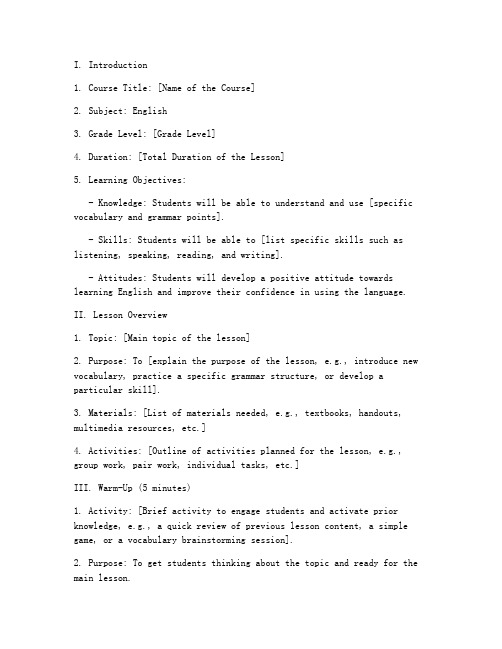
I. Introduction1. Course Title: [Name of the Course]2. Subject: English3. Grade Level: [Grade Level]4. Duration: [Total Duration of the Lesson]5. Learning Objectives:- Knowledge: Students will be able to understand and use [specific vocabulary and grammar points].- Skills: Students will be able to [list specific skills such as listening, speaking, reading, and writing].- Attitudes: Students will develop a positive attitude towards learning English and improve their confidence in using the language.II. Lesson Overview1. Topic: [Main topic of the lesson]2. Purpose: To [explain the purpose of the lesson, e.g., introduce new vocabulary, practice a specific grammar structure, or develop a particular skill].3. Materials: [List of materials needed, e.g., textbooks, handouts, multimedia resources, etc.]4. Activities: [Outline of activities planned for the lesson, e.g., group work, pair work, individual tasks, etc.]III. Warm-Up (5 minutes)1. Activity: [Brief activity to engage students and activate prior knowledge, e.g., a quick review of previous lesson content, a simple game, or a vocabulary brainstorming session].2. Purpose: To get students thinking about the topic and ready for the main lesson.IV. Main Content (25 minutes)1. Vocabulary and Grammar Focus:- Vocabulary: [List of new vocabulary words and phrases with examples of use].- Grammar: [Explanation of the specific grammar point(s) to be covered].2. Activity 1: [Activity Name]- Description: [Detailed description of the activity, including instructions and roles of students].- Purpose: [Explain how this activity helps students learn the vocabulary and grammar focus].3. Activity 2: [Activity Name]- Description: [Detailed description of the activity, including instructions and roles of students].- Purpose: [Explain how this activity reinforces the learning from Activity 1 and further develops the vocabulary and grammar skills].V. Practice (10 minutes)1. Activity 1: [Activity Name]- Description: [Detailed description of the activity, including instructions and roles of students].- Purpose: To provide students with opportunities to practice the new vocabulary and grammar in a controlled setting.2. Activity 2: [Activity Name]- Description: [Detailed description of the activity, including instructions and roles of students].- Purpose: To encourage students to use the new vocabulary and grammar in more open-ended and creative ways.VI. Review and Consolidation (5 minutes)1. Activity: [Activity Name]- Description: [Brief activity to review the main points of the lesson, e.g., a quick quiz, a class discussion, or a summary activity].- Purpose: To reinforce learning and ensure that students have understood the key concepts.VII. Homework Assignment1. Task: [Description of the homework assignment, including specific instructions and due date].2. Purpose: To provide students with additional practice outside of the classroom and to reinforce the learning from the lesson.VIII. Assessment1. Formative Assessment:- Observations: Teacher observations during activities.- Class Participation: Students' engagement and contribution during class discussions and activities.2. Summative Assessment:- Homework: Completion and quality of the homework assignment.- Tests/Quizzes: Written tests or quizzes to assess understanding of vocabulary and grammar.IX. Reflection。
中职英语基础模块1学科教学计划

中职英语基础模块1学科教学计划英文回答:The secondary vocational English basic module 1 curriculum plan is designed to provide students with a strong foundation in the English language, focusing on developing their communication skills, vocabulary, and grammar. It encompasses various aspects of language learning, including listening, speaking, reading, and writing, and incorporates interactive and engaging activities to enhance student engagement and learning outcomes.中文回答:一、课程目标。
本课程旨在为学生打下扎实的英语基础,重点培养他们的交流能力、词汇量和语法。
它包含了语言学习的各个方面,包括听力、口语、阅读和写作,并融入互动和吸引人的活动,以增强学生的参与度和学习成果。
二、课程内容。
1. 听力。
识别和理解日常对话和短文中的关键信息。
推断未明确说明的信息。
识别元音和辅音的发音。
2. 口语。
自信地进行基本的对话。
清晰准确地表达想法和观点。
适当使用语法和词汇。
3. 阅读。
理解和分析不同的文本类型。
提取关键信息并推断含义。
扩大词汇量和提高阅读流利度。
4. 写作。
写出语法正确、连贯的段落和短文。
使用适当的词汇和句型。
遵循正确的标点符号和语法规则。
三、教学方法。
互动式课堂活动。
角色扮演和模拟对话。
分组讨论和项目。
多媒体辅助教学。
差异化教学策略。
四、考核方式。
日常课堂参与。
小测验和作业。
中职英语授课计划
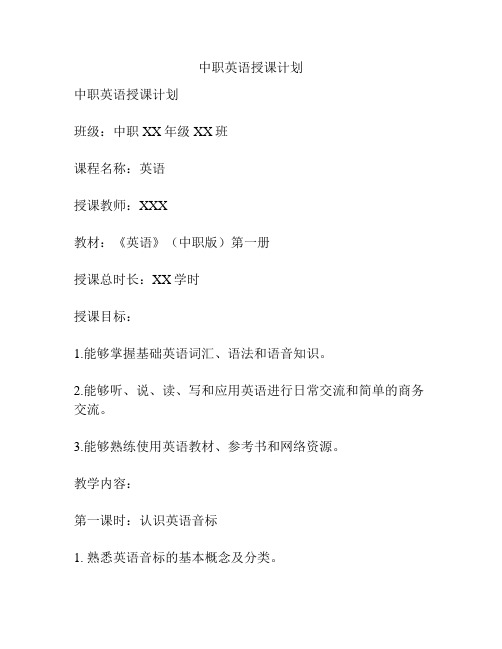
中职英语授课计划中职英语授课计划班级:中职XX年级XX班课程名称:英语授课教师:XXX教材:《英语》(中职版)第一册授课总时长:XX学时授课目标:1.能够掌握基础英语词汇、语法和语音知识。
2.能够听、说、读、写和应用英语进行日常交流和简单的商务交流。
3.能够熟练使用英语教材、参考书和网络资源。
教学内容:第一课时:认识英语音标1. 熟悉英语音标的基本概念及分类。
2. 学习标准英式发音。
3. 练习对单词进行音标注音。
第二课时:问候与自我介绍1. 学习日常问候用语。
2. 练习询问和介绍个人信息。
3. 模拟实际交际场景。
第三课时:购物1. 学习有关购买物品的相关词汇和表达方式。
2. 练习询问物品价格和数量。
3. 培养学生基本的商务交流能力。
第四课时:餐厅用餐1. 学习餐厅用餐中的相关词汇和表达方式。
2. 练习点菜和支付账单。
3. 培养学生在海外旅游时的应对能力。
第五课时:时间和日期1. 学习时间和日期相关的英语表达方式。
2. 练习使用英文书写时间和日期。
3. 进行相关的口语练习和听力训练。
教学方法:1. 教师主导,学生参与的教学方式。
2. 采用多媒体、互联网等现代化教学方法。
3. 引导学生积极参与课堂讨论和互动。
4. 结合实际语言环境,增强学生语感和应用能力。
评价方式:1. 单元考试成绩占总评成绩的50%。
2. 平时表现和课堂表现占总评成绩的30%。
3. 课后作业和参与度占总评成绩的20%。
备注:课程内容和时长可根据实际情况进行调整。
中职英语教案万能模板范文

---课程名称:中职英语授课班级: [班级名称]授课教师: [教师姓名]授课时间: [日期]教学目标:1. 知识目标:让学生掌握本节课的核心词汇和句型,能够运用所学知识进行简单的交流。
2. 能力目标:提高学生的听说读写能力,特别是口语表达和听力理解能力。
3. 情感目标:培养学生对英语学习的兴趣,增强自信心,激发学习动力。
教学内容:[本节课具体教学内容,如单元主题、具体课文等]教学重难点:1. 重点: [本节课的重点内容,如特定词汇、句型、语法点等]2. 难点: [本节课的难点内容,如复杂句型、难懂词汇等]教学过程:一、导入(Warm-up)1. 活动:通过歌曲、游戏或简短对话等方式活跃课堂气氛,让学生放松心情,为正式上课做好准备。
2. 时间: 5分钟二、新课导入(New lesson Introduction)1. 活动:通过PPT、图片、视频等方式展示本节课的核心词汇和句型,引导学生进入学习状态。
2. 时间: 10分钟三、词汇学习(Vocabulary Learning)1. 活动:通过例句、游戏、卡片等形式帮助学生记忆词汇,并理解其用法。
2. 时间: 15分钟四、句型练习(Sentence Practice)1. 活动:设计对话、角色扮演等环节,让学生运用所学句型进行交流。
2. 时间: 15分钟五、语法讲解(Grammar Explanation)1. 活动:简要讲解本节课涉及的语法点,通过例句和练习帮助学生理解和掌握。
2. 时间: 10分钟六、听力训练(Listening Practice)1. 活动:播放听力材料,让学生进行听力练习,并回答相关问题。
2. 时间: 15分钟七、总结与作业布置(Summary and Homework Assignment)1. 活动:对本节课的学习内容进行总结,布置适量的作业,巩固所学知识。
2. 时间: 5分钟教学反思:[教师对本节课的教学效果进行反思,包括教学方法的运用、学生的学习情况、存在的问题及改进措施等]---教学资源:[本节课所需的教学资源,如教材、PPT、图片、音频、视频等]备注:1. 教师可根据实际情况调整教学时间。
中职英语基础模块1学科教学计划

中职英语基础模块1学科教学计划English Response:Curriculum Plan for English Foundation Module 1 in Vocational Secondary School.Course Objectives:To develop students' basic English language skills in listening, speaking, reading, and writing.To enhance students' vocabulary, grammar, and functional language knowledge.To improve students' ability to communicate effectively in English in both academic and vocational settings.To foster students' interest in English language and culture.Course Content:Unit 1: Personal Information and Daily Life. Greetings and introductions.Describing oneself and others.Daily routines and activities.Unit 2: Family and Friends.Family members and relationships.Making friends and social interactions.Unit 3: School Life.School subjects and classes.School activities and events.Unit 4: Food and Dining.Types of food and drinks.Dining customs and etiquette.Unit 5: Travel and Transportation.Modes of transportation.Travel experiences and arrangements. Unit 6: Shopping and Services.Types of shops and services.Shopping for goods and services.Unit 7: Health and Well-being.Common ailments and illnesses.Health and fitness vocabulary.Unit 8: Technology and Entertainment. Electronic devices and their uses.Entertainment activities and hobbies. Unit 9: Work and Career.Types of jobs and careers.Job search and interview skills.Assessment:Regular quizzes and assignments.Mid-term exam.Final exam.Oral presentation.Writing portfolio.Methodology:Communicative approach with emphasis on authentic materials.Task-based learning to promote language use in real-world contexts.Cooperative learning to foster collaboration and peer support.Technology-enhanced instruction to engage students and facilitate learning.Differentiated instruction to cater to students with diverse learning needs.Resources:Textbook: English for Vocational Secondary Schools, Volume 1。
中等职业学校英语教材教案unit

中等职业学校英语教材教案Unit 1一、教学目标1. 知识目标:(1)能够正确理解并使用本单元的核心词汇和短语。
(2)能够听懂、说出一般现在时的句子。
(3)能够理解并运用本单元所学的语法知识。
2. 能力目标:(1)能够用英语进行简单的日常交流。
(2)能够阅读并理解简单的故事或说明文。
(3)能够运用所学知识进行写作。
3. 情感目标:(1)培养学生对英语学习的兴趣和自信心。
(2)培养学生积极主动参与课堂活动的习惯。
二、教学内容1. 核心词汇和短语:(1)词汇:如job, pany, friend 等。
(2)短语:如work at, live in, go to school 等。
2. 语法知识:一般现在时。
3. 对话或故事:描述人们的工作、生活和学习情况。
三、教学重点与难点1. 重点:(1)本单元的核心词汇和短语。
(2)一般现在时的句子结构和用法。
2. 难点:(1)一般现在时的句子结构的运用。
(2)词汇和短语的准确运用。
四、教学方法1. 交际法:通过模拟真实情境,让学生在实际交流中学习英语。
2. 任务型教学法:通过完成各种任务,提高学生的综合语言运用能力。
3. 语法翻转教学法:通过先让学生自主探究语法知识,再进行讲解和练习。
五、教学步骤1. 热身活动:(1)与学生进行简单的英语对话,检查他们的英语水平。
(2)引导学生回顾前一单元所学的内容。
2. 引入新课:(1)介绍本单元的主题和目标。
(2)展示本单元的核心词汇和短语。
3. 新课讲解:(1)讲解一般现在时的句子结构和用法。
(2)举例说明一般现在时的句子。
4. 课堂练习:(1)让学生进行小组活动,用一般现在时造句。
(2)选取部分学生的句子进行点评和纠正。
(2)布置作业:要求学生用一般现在时写一篇短文。
六、教学评估1. 课堂参与度:观察学生在课堂活动中的参与情况,了解他们的学习状态。
2. 口语表达:评估学生在口语交流中的词汇运用、语法准确性和表达流畅性。
中专语法英语教案设计模板

---一、课程基本信息课程名称:中专英语语法授课对象:中专一年级学生课时安排: 2课时教学目标:知识与技能:掌握本节课所涉及的语法知识点,并能运用到实际的语言交流中。
过程与方法:通过小组讨论、角色扮演等方式,提高学生的语言实践能力。
情感态度与价值观:培养学生对英语学习的兴趣,增强学习英语的自信心。
二、教学内容教学重点:本节课的语法知识点,如时态、语态、非谓语动词等。
语法知识的实际运用。
教学难点:语法知识的深入理解和灵活运用。
在复杂句子中识别和运用正确的语法结构。
三、教学过程第一课时1. 导入(5分钟)通过播放与主题相关的英语歌曲或视频,激发学生的学习兴趣。
提问学生关于歌曲或视频的内容,引导学生进入学习状态。
2. 新课讲授(25分钟)以PPT或黑板的形式,清晰地展示本节课的语法知识点。
结合例句,讲解语法规则,并强调重点和难点。
鼓励学生积极参与课堂互动,提问并解答学生的疑问。
3. 练习巩固(20分钟)分组进行语法练习,如填空、改错、翻译等。
教师巡视课堂,个别指导,帮助学生解决问题。
4. 课堂小结(5分钟)总结本节课所学内容,强调重点和难点。
布置课后作业,巩固所学知识。
第二课时1. 复习回顾(5分钟)回顾上节课所学内容,检查学生对知识的掌握情况。
针对学生的疑问,进行个别辅导。
2. 应用拓展(25分钟)设计与主题相关的情景对话或短文阅读,让学生运用所学语法知识进行表达。
引导学生进行小组讨论或角色扮演,提高语言实践能力。
3. 总结反思(10分钟)总结本节课所学内容,分享学习心得。
强调语法知识在实际语言交流中的重要性。
4. 布置作业(5分钟)布置课后作业,如完成练习册、翻译短文等,巩固所学知识。
四、教学评价课堂表现:观察学生在课堂上的参与度、提问回答情况等。
作业完成情况:检查学生的课后作业完成情况,了解学生对知识的掌握程度。
学习成果:通过课堂练习、考试等方式,评估学生对语法知识的掌握和应用能力。
---五、教学反思教师应关注学生的个体差异,针对不同学生的学习情况,采取不同的教学方法。
中职学科教学计划英语

中职学科教学计划英语English Teaching Plan for Secondary Vocational Education.I. Introduction.In the context of globalization and the ever-increasing demand for skilled professionals with cross-cultural communication abilities, English has become an indispensable tool in vocational education. This teaching plan aims to outline a comprehensive English curriculum for secondary vocational students, focusing on developing their language proficiency, vocational-specific language skills, and cultural awareness.II. Objectives.1. Language Proficiency: To enhance students' basic language skills in listening, speaking, reading, and writing.2. Vocational Language Skills: To cultivate students' ability to communicate effectively in English in their chosen vocational field.3. Cultural Awareness: To foster an understanding and appreciation of English-speaking cultures and promotecross-cultural communication.III. Content and Structure.The English curriculum for secondary vocational students will be structured into four main components: foundational skills, vocational language, cultural studies, and practical application.1. Foundational Skills:Grammar and Vocabulary: Focus on essential grammar structures and vocabulary related to daily life and vocational contexts.Listening and Speaking: Develop students' ability to understand spoken English and communicate effectively in conversational settings.Reading and Writing: Enhance reading comprehension and writing skills, including basic text analysis andwriting for different purposes.2. Vocational Language:Industry-Specific Vocabulary: Introduce terminology and jargon related to the students' chosen vocational field.Workplace Communication: Train students in workplace communication skills.。
中职英语基础模块一教学计划

中职英语基础模块一教学计划Alright, here's a sample teaching plan for the Basic English Module 1 in a vocational school, written in an informal and conversational English style:Let's start with the basics! We'll kick off our journey with a focus on the alphabet and pronunciation. It's essential to get the sounds right from the beginning.Moving on, we'll dive into simple greetings and introductions. It's all about those first impressions, so let's make them count! We'll practice saying "Hello!", "My name is...", and other basic phrases.After that, we'll tackle some daily vocabulary. It's time to learn about common objects and activities we encounter in our daily lives. Words like "pen," "book," "eat," and "sleep" will be our friends.Now, let's talk about numbers. Counting is a crucialskill, whether it's for math or just keeping track of things. We'll learn to count from one to ten, and then some more!Speaking of communication, let's practice asking and answering questions. This is a fundamental skill that'll help us understand each other better. We'll work on questions like "What's your favorite food?" and "Where do you come from?"Next up, we'll explore simple grammar rules. Don't worry, it's not as scary as it sounds!。
教学工作计划英语中职高一
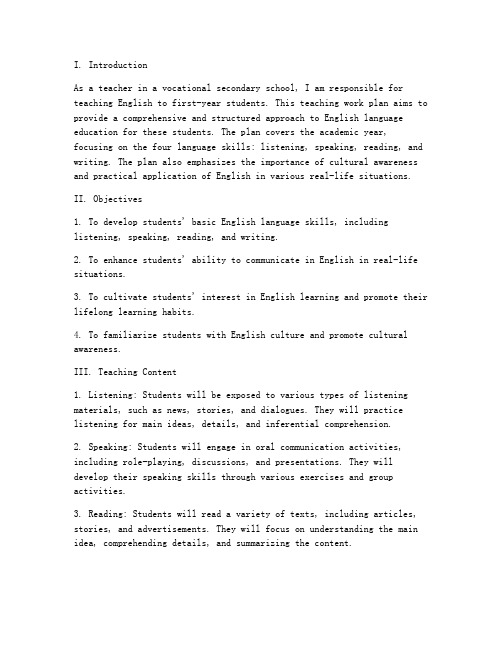
I. IntroductionAs a teacher in a vocational secondary school, I am responsible for teaching English to first-year students. This teaching work plan aims to provide a comprehensive and structured approach to English language education for these students. The plan covers the academic year, focusing on the four language skills: listening, speaking, reading, and writing. The plan also emphasizes the importance of cultural awareness and practical application of English in various real-life situations.II. Objectives1. To develop students' basic English language skills, including listening, speaking, reading, and writing.2. To enhance students' ability to communicate in English in real-life situations.3. To cultivate students' interest in English learning and promote their lifelong learning habits.4. To familiarize students with English culture and promote cultural awareness.III. Teaching Content1. Listening: Students will be exposed to various types of listening materials, such as news, stories, and dialogues. They will practice listening for main ideas, details, and inferential comprehension.2. Speaking: Students will engage in oral communication activities, including role-playing, discussions, and presentations. They will develop their speaking skills through various exercises and group activities.3. Reading: Students will read a variety of texts, including articles, stories, and advertisements. They will focus on understanding the main idea, comprehending details, and summarizing the content.4. Writing: Students will write different types of essays, such as narratives, descriptions, and arguments. They will learn to organize their thoughts logically and express their ideas clearly.IV. Teaching Methods1. Task-based learning: Students will be involved in various tasks related to real-life situations, promoting their practical application of English.2. Collaborative learning: Students will work in groups to complete tasks, encouraging communication and teamwork.3. Technology integration: Utilize multimedia tools, such as videos, audios, and online resources, to enhance the learning experience.4. Project-based learning: Assign projects that require students to research and present information, fostering critical thinking and research skills.V. Assessment1. Formative assessment: Regular quizzes, homework, and oral presentations will be used to monitor students' progress and provide feedback.2. Summative assessment: Final exams and projects will be conducted to evaluate students' overall performance.3. Self-assessment and peer-assessment: Encourage students to reflect on their learning and provide feedback to their peers.VI. Time Management1. Class time: Allocate 45 minutes for each lesson, ensuring that students have enough time to practice and interact.2. Homework: Assign homework weekly, providing students with opportunities to reinforce their learning outside the classroom.3. Extra-curricular activities: Organize English clubs, debates, and cultural exchange programs to promote language practice and cultural understanding.VII. ConclusionThis teaching work plan aims to provide a comprehensive and structured approach to English language education for first-year vocational secondary school students. By focusing on the four language skills, cultural awareness, and practical application, I hope to help students develop a strong foundation in English and cultivate their passion for learning. Regular assessment and feedback will ensure continuous improvement and success in their English studies.。
中职英语教案模板范文
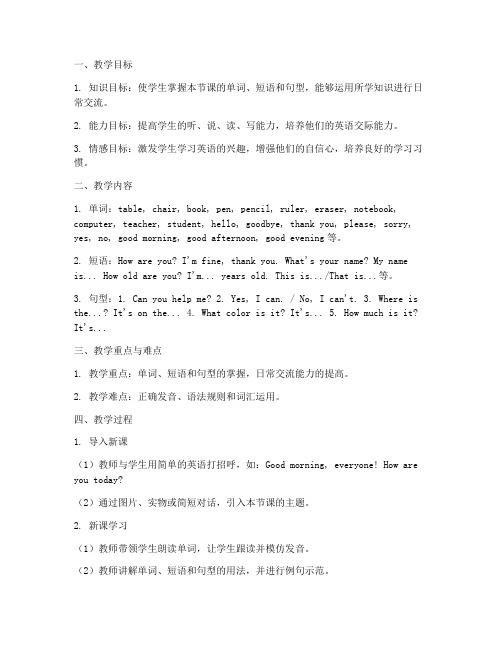
一、教学目标1. 知识目标:使学生掌握本节课的单词、短语和句型,能够运用所学知识进行日常交流。
2. 能力目标:提高学生的听、说、读、写能力,培养他们的英语交际能力。
3. 情感目标:激发学生学习英语的兴趣,增强他们的自信心,培养良好的学习习惯。
二、教学内容1. 单词:table, chair, book, pen, pencil, ruler, eraser, notebook, computer, teacher, student, hello, goodbye, thank you, please, sorry, yes, no, good morning, good afternoon, good evening等。
2. 短语:How are you? I'm fine, thank you. What's your name? My name is... How old are you? I'm... years old. This is.../That is...等。
3. 句型:1. Can you help me? 2. Yes, I can. / No, I can't. 3. Where is the...? It's on the...4. What color is it? It's...5. How much is it? It's...三、教学重点与难点1. 教学重点:单词、短语和句型的掌握,日常交流能力的提高。
2. 教学难点:正确发音、语法规则和词汇运用。
四、教学过程1. 导入新课(1)教师与学生用简单的英语打招呼,如:Good morning, everyone! How are you today?(2)通过图片、实物或简短对话,引入本节课的主题。
2. 新课学习(1)教师带领学生朗读单词,让学生跟读并模仿发音。
(2)教师讲解单词、短语和句型的用法,并进行例句示范。
中职英语教案范文全英文版
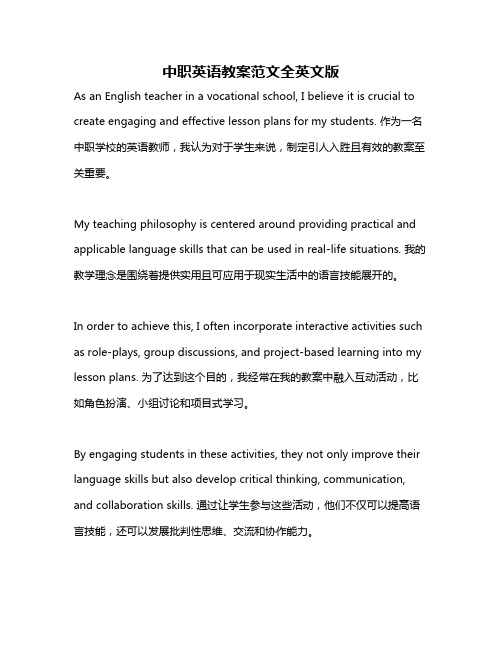
中职英语教案范文全英文版As an English teacher in a vocational school, I believe it is crucial to create engaging and effective lesson plans for my students. 作为一名中职学校的英语教师,我认为对于学生来说,制定引人入胜且有效的教案至关重要。
My teaching philosophy is centered around providing practical and applicable language skills that can be used in real-life situations. 我的教学理念是围绕着提供实用且可应用于现实生活中的语言技能展开的。
In order to achieve this, I often incorporate interactive activities such as role-plays, group discussions, and project-based learning into my lesson plans. 为了达到这个目的,我经常在我的教案中融入互动活动,比如角色扮演、小组讨论和项目式学习。
By engaging students in these activities, they not only improve their language skills but also develop critical thinking, communication, and collaboration skills. 通过让学生参与这些活动,他们不仅可以提高语言技能,还可以发展批判性思维、交流和协作能力。
I also believe in the importance of incorporating real-world examples and cultural references into my lessons to make the content more relatable and interesting for students. 我还相信在我的课堂中融入现实世界的例子和文化参考对于让学生更容易理解和感兴趣。
中职学生学习计划英语
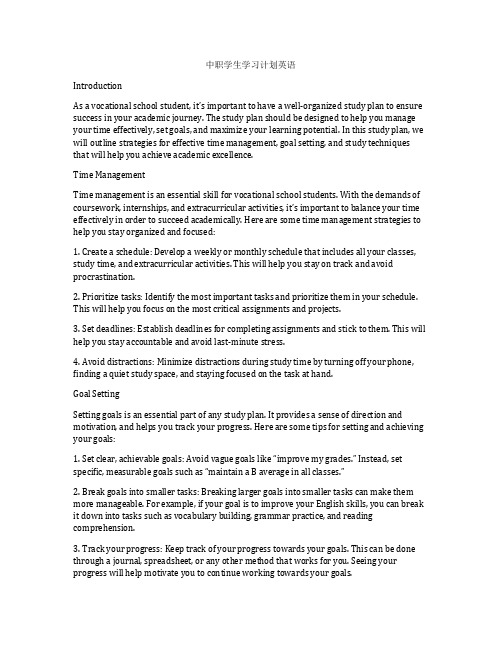
中职学生学习计划英语IntroductionAs a vocational school student, it’s important to have a well-organized study plan to ensure success in your academic journey. The study plan should be designed to help you manage your time effectively, set goals, and maximize your learning potential. In this study plan, we will outline strategies for effective time management, goal setting, and study techniques that will help you achieve academic excellence.Time ManagementTime management is an essential skill for vocational school students. With the demands of coursework, internships, and extracurricular activities, it’s important to balance your time effectively in order to succeed academically. Here are some time management strategies to help you stay organized and focused:1. Create a schedule: Develop a weekly or monthly schedule that includes all your classes, study time, and extracurricular activities. This will help you stay on track and avoid procrastination.2. Prioritize tasks: Identify the most important tasks and prioritize them in your schedule. This will help you focus on the most critical assignments and projects.3. Set deadlines: Establish deadlines for completing assignments and stick to them. This will help you stay accountable and avoid last-minute stress.4. Avoid distractions: Minimize distractions during study time by turning off your phone, finding a quiet study space, and staying focused on the task at hand.Goal SettingSetting goals is an essential part of any study plan. It provides a sense of direction and motivation, and helps you track your progress. Here are some tips for setting and achieving your goals:1. Set clear, achievable goals: Avoid vague goals like “improve my grades.” Instead, set specific, measurable goals such as “maintain a B average in all classes.”2. Break goals into smaller tasks: Breaking larger goals into smaller tasks can make them more manageable. For example, if your goal is to improve your English skills, you can break it down into tasks such as vocabulary building, grammar practice, and reading comprehension.3. Track your progress: Keep track of your progress towards your goals. This can be done through a journal, spreadsheet, or any other method that works for you. Seeing your progress will help motivate you to continue working towards your goals.Study TechniquesEffective study techniques are essential for retaining information and understanding course material. Here are some study techniques to help you succeed in your vocational school courses:1. Active learning: Engage with the material by asking questions, participating in discussions, and applying what you’ve learned to real-life situations. This will help you understand the material on a deeper level.2. Use study aids: Utilize study aids such as flashcards, mnemonic devices, and study guides to reinforce learning and improve retention.3. Practice time management: Take practice tests and time yourself to simulate exam conditions. This will help you manage your time effectively during exams.4. Seek help when needed: Don’t be afraid to ask for help when you’re struggling with a topic. Your teachers, peers, and tutors are all valuable resources that can help you understand difficult concepts.ConclusionCreating a study plan is essential for vocational school students who want to excel academically. By implementing time management strategies, setting clear goals, and using effective study techniques, you can maximize your learning potential and achieve academic success. Remember to review and adjust your study plan as needed, and stay focused on your goals. With dedication and hard work, you can achieve your academic aspirations and excel in your vocational school studies.。
职业中学教学工作计划英语

I. IntroductionThe purpose of this teaching work plan is to outline the goals, strategies, and activities for the upcoming academic year at our vocational secondary school. This plan aims to ensure that our students receive a comprehensive and practical education that prepares them for successful careers in their chosen fields. The plan will cover the following key areas: curriculum development, teaching methods, student assessment, and professional development for teachers.II. Goals and Objectives1. Curriculum Development:- Update the curriculum to align with the latest industry standards and trends.- Introduce new courses that are in demand in the job market.- Enhance the practical components of the curriculum to provide hands-on learning experiences.2. Teaching Methods:- Implement a blend of traditional and innovative teaching methods to cater to different learning styles.- Encourage student-centered learning by promoting group work,project-based assignments, and interactive discussions.- Use technology effectively to enhance teaching and learning processes.3. Student Assessment:- Develop a comprehensive assessment system that evaluates students' knowledge, skills, and attitudes.- Conduct regular formative assessments to monitor student progress and provide timely feedback.- Administer summative assessments at the end of each semester to measure student achievement.4. Professional Development:- Organize regular workshops and training sessions for teachers to keep them updated with the latest teaching techniques and industry knowledge.- Encourage teachers to participate in professional development programs and conferences.- Foster a culture of continuous improvement and collaboration among the teaching staff.III. Strategies and Activities1. Curriculum Development:- Conduct a thorough review of the current curriculum and identify areas for improvement.- Collaborate with industry experts to design new courses and update existing ones.- Integrate real-world case studies and practical exercises into the curriculum.2. Teaching Methods:- Use a variety of teaching methods such as lectures, discussions, demonstrations, and hands-on activities.- Implement flipped classroom techniques where students watch lectures at home and spend class time on practical work.- Introduce e-learning platforms to provide students with access to additional resources and materials.3. Student Assessment:- Design assessments that are aligned with the learning objectives of each course.- Use a mix of written exams, practical tests, and project assessments to evaluate students' performance.- Provide detailed feedback to students on their strengths and areas for improvement.4. Professional Development:- Organize monthly professional development workshops on topics such as classroom management, student engagement, and curriculum design.- Offer opportunities for teachers to attend external conferences and seminars.- Establish a mentorship program where experienced teachers guide and support new teachers.IV. Timeline and Implementation1. September to November:- Review and update the curriculum.- Train teachers on new teaching methods and technologies.- Introduce new courses and revise existing ones.2. December to February:- Implement the updated curriculum.- Conduct formative assessments to monitor student progress.- Provide feedback and support to students as needed.3. March to May:- Prepare for summative assessments.- Organize professional development workshops for teachers.- Evaluate the effectiveness of the teaching methods and curriculum.4. June to August:- Analyze the results of summative assessments.- Develop a plan for addressing any identified areas of improvement.- Prepare for the next academic year by reviewing and updating the curriculum.V. ConclusionThis teaching work plan sets the foundation for a successful academic year at our vocational secondary school. By focusing on curriculum development, innovative teaching methods, comprehensive assessment, and professional development, we aim to provide our students with the best possible education and prepare them for fulfilling careers. Through continuous improvement and collaboration, we will strive to meet the evolving needs of our students and the industry.。
中职英语教案范文全英文版
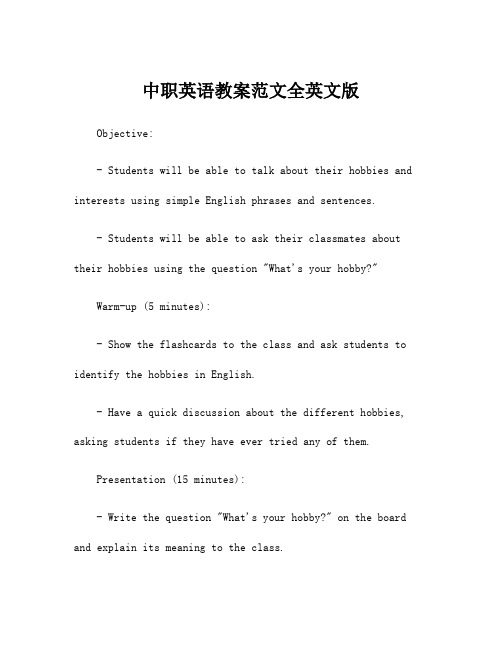
中职英语教案范文全英文版Objective:- Students will be able to talk about their hobbies and interests using simple English phrases and sentences.- Students will be able to ask their classmates about their hobbies using the question "What's your hobby?"Warm-up (5 minutes):- Show the flashcards to the class and ask students to identify the hobbies in English.- Have a quick discussion about the different hobbies, asking students if they have ever tried any of them.Presentation (15 minutes):- Write the question "What's your hobby?" on the board and explain its meaning to the class.- Show a few examples of answers to the question and elicit responses from the students.- Use the flashcards to elicit more specific vocabulary related to each hobby, such as "paintbrush," "goalkeeper," "book," etc.Practice (20 minutes):- Divide the class into pairs and ask them to take turns asking each other about their hobbies using the question "What's your hobby?"- Circulate around the room, monitoring the students' conversations and providing assistance as needed.- After a few minutes, ask a few pairs to share their conversations with the class.Production (15 minutes):- Hand out the worksheet with conversation starters about hobbies and ask the students to fill in the blanks with their own answers.- Once they have completed the worksheet, students should pair up again and take turns asking and answering the questions with their partners.Wrap-up (5 minutes):- Ask a few students to share what they learned about their classmates' hobbies during the practice activity.- Review any vocabulary or phrases that students struggled with and provide additional examples if necessary.Homework:- Students should write a short paragraph about their favorite hobby, using the vocabulary and phrases they learned in class.。
中职英语基础模块授课计划
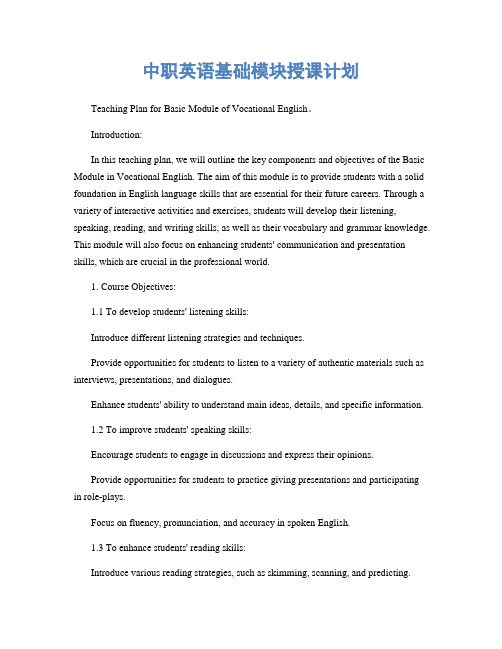
中职英语基础模块授课计划Teaching Plan for Basic Module of Vocational English。
Introduction:In this teaching plan, we will outline the key components and objectives of the Basic Module in Vocational English. The aim of this module is to provide students with a solid foundation in English language skills that are essential for their future careers. Through a variety of interactive activities and exercises, students will develop their listening, speaking, reading, and writing skills, as well as their vocabulary and grammar knowledge. This module will also focus on enhancing students' communication and presentation skills, which are crucial in the professional world.1. Course Objectives:1.1 To develop students' listening skills:Introduce different listening strategies and techniques.Provide opportunities for students to listen to a variety of authentic materials such as interviews, presentations, and dialogues.Enhance students' ability to understand main ideas, details, and specific information.1.2 To improve students' speaking skills:Encourage students to engage in discussions and express their opinions.Provide opportunities for students to practice giving presentations and participatingin role-plays.Focus on fluency, pronunciation, and accuracy in spoken English.1.3 To enhance students' reading skills:Introduce various reading strategies, such as skimming, scanning, and predicting.Expose students to different types of texts, including articles, reports, and advertisements.Develop students' comprehension skills, including understanding main ideas, supporting details, and inferences.1.4 To strengthen students' writing skills:Teach students the basics of effective writing, including organizing ideas, using appropriate vocabulary and grammar, and structuring paragraphs.Provide opportunities for students to practice different types of writing, such as emails, reports, and essays.Focus on improving students' ability to express themselves clearly and coherently in written English.1.5 To expand students' vocabulary and grammar knowledge:Introduce new vocabulary related to various industries and professions.Teach essential grammar rules and structures through interactive exercises and activities.Provide opportunities for students to practice using new vocabulary and grammar in context.1.6 To develop students' communication and presentation skills:Teach effective communication strategies, such as active listening, asking clarifying questions, and giving feedback.Provide opportunities for students to practice delivering presentations and participating in group discussions.Focus on developing students' ability to communicate confidently and professionally.2. Teaching Methods:2.1 Interactive activities:Engage students in pair and group work activities to encourage active participation and collaboration.Use multimedia resources, such as videos, audio recordings, and online platforms, to make the learning experience more interactive and engaging.2.2 Real-world applications:Incorporate real-life scenarios and case studies to make the content relevant and practical for students.Encourage students to apply their language skills in authentic situations, such as job interviews and workplace interactions.2.3 Continuous assessment:Regularly assess students' progress through quizzes, tests, and assignments.Provide constructive feedback to help students identify areas for improvement and track their language development.3. Evaluation:3.1 Formative assessment:Monitor students' progress throughout the module through class participation, homework, and in-class activities.Provide ongoing feedback to guide students' learning and address any difficulties they may encounter.3.2 Summative assessment:Administer a final examination to assess students' overall language proficiency.Evaluate students' listening, speaking, reading, and writing skills, as well as their vocabulary and grammar knowledge.Conclusion:The Basic Module of Vocational English aims to equip students with essential language skills and communication abilities necessary for their future careers. By focusing on listening, speaking, reading, writing, vocabulary, grammar, and communication skills, this module provides a comprehensive foundation for further language development. Through interactive activities, real-world applications, and continuous assessment, students will be able to enhance their English proficiency and confidently communicate in professional settings.。
- 1、下载文档前请自行甄别文档内容的完整性,平台不提供额外的编辑、内容补充、找答案等附加服务。
- 2、"仅部分预览"的文档,不可在线预览部分如存在完整性等问题,可反馈申请退款(可完整预览的文档不适用该条件!)。
- 3、如文档侵犯您的权益,请联系客服反馈,我们会尽快为您处理(人工客服工作时间:9:00-18:30)。
编号:中等专业学校
学期授课进度计划
(201 —201 学年度第一学期)
课程名称英语
班级
任课教师
教研组英语
制定日期201 年8 月31 日
学期授课计划说明
一、学期授课计划是教师在整个学期内进行教学工作的依据,是教学的基本文件之一。
二、学期授课计划由教师在每学期开学前按所担任的课程分别编写,写好后由教研组讨论通过。
教研组长签字、专业部初审、教务科复查,经分管校长批准后由教师遵照执行。
三、如几个教师同时任相同课程,可共同编写计划,每个教师各存一份,以便统一进行教学工作。
四、学期授课计划应按教学计划和教学大纲规定的时数和内容编写,如某种原因需要调整时,应事前报经教务科(处)批准。
五、计划中课时分配以2课时为单位,单节课以1课时为单位。
六、编写学期授课计划应按下列提纲编写:
1、本计划内容在本课程中所应达到的目的要求;
2、与教学大纲相比,在顺序、时数、内容上有无差别,差别在哪里?什么原因?
3、教具如何解决?
4、作业如何确定?作业份量如何?
5、实验如何安排?
6、和其他课程的配合如何?。
